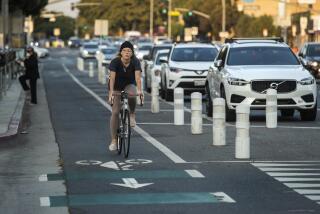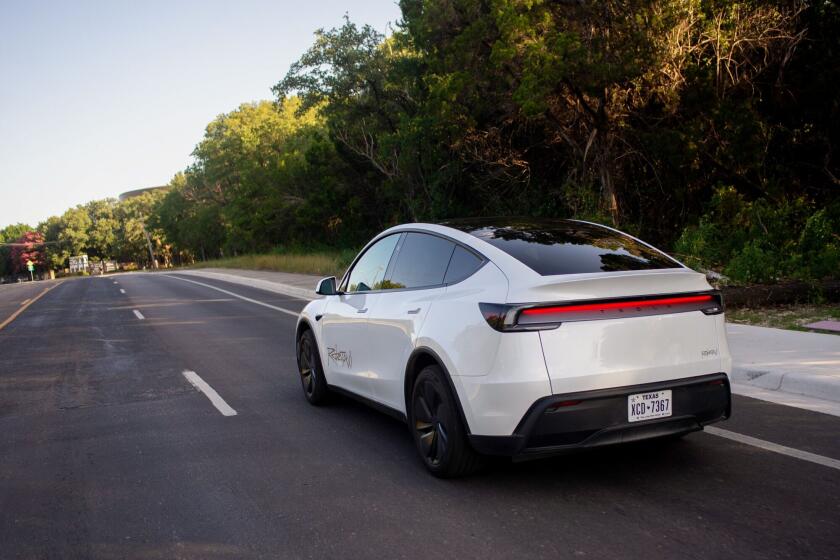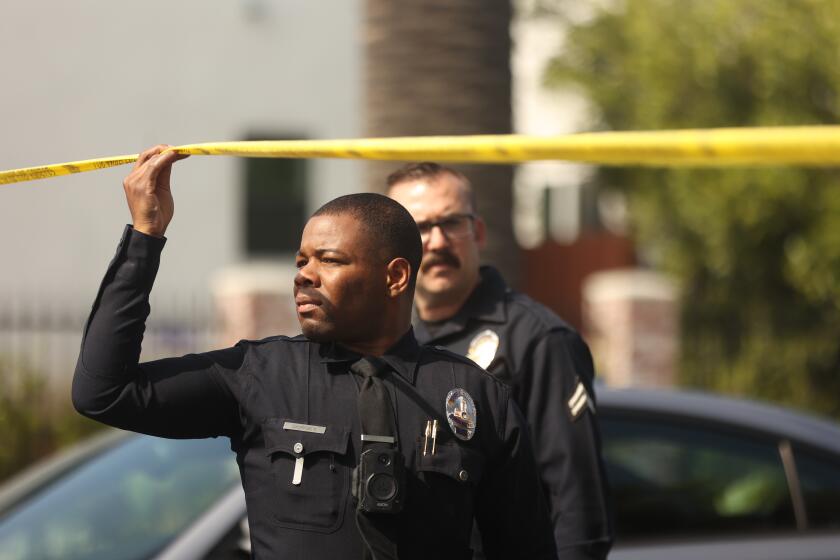Motorist Says Absence of Merge Arrows Points to a Safety Hazard
- Share via
Dear Street Smart:
I would like your assistance in correcting a safety problem that I see almost daily. This occurs with northbound traffic on Harbor Boulevard after the intersection of Bastanchury Road in Fullerton.
Harbor Boulevard has three lanes coming out of the intersection, then merges into two lanes. While there is a standard merging sign posted some distance from the intersection, there are no customary arrows on the pavement indicating merging lanes.
What I constantly see is a race by the curb-lane cars to merge from the right to cut into the second lane either by choice or by failure to see the yellow traffic merging sign. Before there is a serious accident here, could you please call this to the attention of the proper authority?
Marv Gonsior Fullerton Paul Smith, traffic engineer for the city of Fullerton, said he thought arrows were painted on Harbor Boulevard to indicate merging lanes after the Bastanchury intersection. Typically, painted arrows accompany posted road side signs, he said.
Whether the painted arrows faded or were never there, Smith agrees that arrows should be there and his department will investigate. He encourages you to call him later this week to find out the results of this investigation. The phone number for Fullerton’s traffic engineering department is (714) 738-6845.
Dear Street Smart:
When turning from a single left-turn lane to a street with multiple lanes, am I restricted as to which lane I can turn to? My niece in Milwaukee says she failed her driver’s test because she turned to the right lane rather than the left.
I thought it was legal to turn to any lane. What is the law in California?
Dave Kraus Fountain Valley You are right. The state law says if you are in a single left-turn lane, you can turn into any lane of a multiple-lane street as long as it is safe, said Bill Madison, a spokesman for the California Department of Motor Vehicles in Sacramento.
Dear Street Smart:
I would like to ask why ramp meters stay on and cycle when traffic is moving at 55 m.p.h. or above. I know that Caltrans will say that it improves traffic flow; however, these lights’ being on when traffic is moving at 55 m.p.h. or more actually impedes traffic.
So many of these ramp meters are so far onto the ramp that when one must stop, and then re-accelerate to 55 m.p.h., it causes a backup because that person is not going the rate that the rest of the traffic is going. To prove this point, see the northbound Katella or Lincoln avenues on-ramps to the Costa Mesa Freeway.
Another prime example is the eastbound Imperial Highway on-ramp to the Riverside Freeway. Most often, these meters are too close to the freeway traffic flow, which (is impeded by) people who stopped at the meter and then could not re-accelerate to the rate of the other drivers on the freeway.
This is an accident waiting to happen. If traffic flow is below full highway speeds, then they work great. But if the speeds on the freeway climb above 55 m.p.h., they should automatically shut off.
Matthew Lahr Orange As you predicted, Caltrans does not agree with you. Rose Orem, a spokeswoman for Caltrans, said that agency does not believe the locations of meters and length of acceleration lanes create a dangerous situation.
Ramp meters are set to go on when freeway traffic reaches a high volume, which usually means that it also slows. When the volume drops (and speeds normally increase), the meters automatically shut off.
Of the placement of the meters near the freeway, Orem said that allows the most number of cars on the ramp at a time, avoiding a backup to the street.
*
The Orange County Transportation Authority’s board of directors is expected to give final approval today to a plan to accommodate the growing demands for transportation for people with disabilities.
The plan eliminates some Dial-A-Ride services for able-bodied senior citizens, but maintains group service to senior citizen centers for nutrition and adult day health care programs.
Also approved was an increase in OCTA ACCESS fares from $1.50 to $2 per ride. OCTA ACCESS provides door-to-door van service for people with disabilities who are unable to use regular, fixed-route buses.
Street Smart appears Mondays in The Times Orange County Edition. Readers are invited to submit comments and questions about traffic, commuting and what makes it difficult to get around in Orange County. Include simple sketches if helpful. Letters may be published in upcoming columns. Please write to Caroline Lemke, c/o Street Smart, The Times Orange County, P.O. Box 2008, Costa Mesa, Calif. 92626. Include your full name, address and day and evening phone numbers. Letters may be edited, and no anonymous letters will be accepted.
More to Read
Sign up for Essential California
The most important California stories and recommendations in your inbox every morning.
You may occasionally receive promotional content from the Los Angeles Times.












